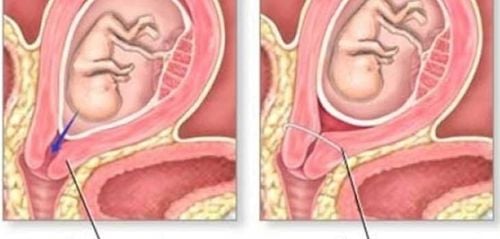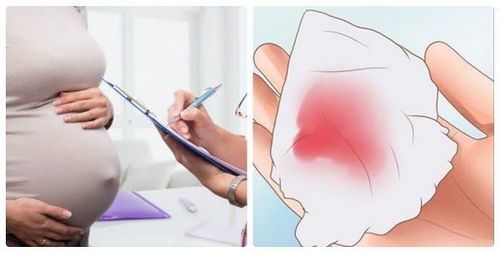This is an automatically translated article.
A cervical stitch is a procedure performed when a woman is at risk for preterm labor. The ideal stitch is around 12 to 14 weeks of pregnancy. So when will these cervical stitches be removed?
1. What is cervical stitch?
Cervical cerclage, also known as cerclage, is a procedure performed during pregnancy in which your doctor stitches up your cervix. The cervix is a funnel-shaped structure that opens at the end of pregnancy during childbirth so that the baby can move out of the uterus and through the vagina.
In abnormal pregnancies such as risk of preterm labor such as (history of large miscarriage or short cervical length), the doctor will perform cervical stitches with the aim of prolonging your pregnancy. You can perform this technique at a hospital or surgery center. And you can completely leave the hospital the same day after the procedure is done.

Bác sĩ sẽ khâu kín cổ tử cung và tháo chỉ trong những tuần cuối cùng của thai kỳ
2. When is cervical stitch done?
As your body begins to go into labor and prepare for birth, the cervix begins to thin or widen. But if your cervix is weak or has other abnormalities, it may open too soon for the intended time. This can lead to an increased risk of premature birth or miscarriage.
The medical centers you visit may recommend cervical stitches during pregnancy to prevent preterm birth if you:
History of second trimester miscarriage, related to painless dilation of the cervix uterus in non-labor or placental abruption (cervical indicated in history) Anterior cervical suture due to cervical dilation in second trimester Cervical dilation diagnosed in second trimester two Short cervical length (less than 25 millimeters) before 24 weeks of pregnancy, in a singleton pregnancy However, cervical stitches are not appropriate for everyone at risk for preterm birth. You may not be offered cervical sutures if you have:
Vaginal bleeding Progressive preterm labor Infections in the uterus Premature rupture of membranes - when a fluid-filled membrane surrounds and cushions the baby during pregnancy period (amniotic sac) leaks or ruptures before 37 weeks of pregnancy Pregnancy with twins or more An anomalous fetus incompatible with life Amniotic sac prolapse - a condition where the amniotic sac protrudes through the opening of the cervix

Trong một số trường hợp thai phụ được chỉ định khâu cổ tử cung để ngăn ngừa sinh non
3. When to perform cervical stitch?
If your doctor recommends a cervical stitch because you've had problems with a previous pregnancy, ideally you should have it done at 12 to 14 weeks. If the procedure is done after this time, it is called an emergency cervical stitch. If you've had a cerclage, you're more likely to have a cerclage this time around, too. Otherwise, you may have surgery up to 24 weeks. Beyond that date, a cervical stitch can cause your amniotic sac to rupture and cause your baby to be born prematurely.
Risks associated with cervical sutures include:
Infection Vaginal bleeding A tear in the cervix (cervical tear) Premature rupture of membranes - when a fluid-filled membrane surrounds and cushions the baby during pregnancy Leaky or ruptured period (amniotic sac) before 37 weeks of pregnancy Suture displacement After having your cervix stitched, contact your healthcare provider immediately if you have vaginal discharge, a signs of premature rupture of membranes. Your doctor will recommend early removal of the cervix if you have premature rupture of membranes or if you have symptoms suggestive of a uterine infection.
SEE ALSO: How does the cervical stitch technique work?

Khâu vòng cổ tử cung được chỉ định khi bạn đã từng gặp vấn đề trong lần mang thai trước
4. When to remove cervical sutures
Vaginal cervix is usually removed around 37 weeks of pregnancy - or when you have symptoms of preterm labor at any gestational age
McDonald's stitches can usually be removed in the office health care provider visits without anesthesia, while the Shirodkar stitch may need to be removed at a hospital or surgery center. After a vaginal hysterectomy, you'll usually be able to resume your normal activities while you wait for labor to begin naturally.
If you are planning to have a cesarean section and plan to have a baby in the future, you can choose to leave your Shirodkar stitches in during your pregnancy and after your baby is born. However, it's possible that stitches could affect your fertility later in life. Consult your healthcare provider about your options.
If you had transabdominal sutures, you will need to make another abdominal incision to remove the cervical suture. Therefore, cesarean section is usually recommended. Your baby will be delivered through an incision above the cervix. During a cesarean section, you can choose to have your cervix removed or keep it for future pregnancies.
Currently, the whole Vinmec system is implementing this technique and has significantly reduced the rate of preterm birth because pregnant women are periodically monitored from the 12-week maternity package, early diagnosis of cervical insufficiency, and treatment. timely.
Vinmec International General Hospital now has a package Maternity service as a solution to help pregnant women feel secure because of the companionship of the medical team throughout the pregnancy. When choosing Maternity Package, pregnant women can:
The pregnancy process is monitored by a team of highly qualified doctors Regular check-ups, early detection of abnormalities The Package Maternity package helps to facilitate convenient for the birthing process Newborns get comprehensive care
Please dial HOTLINE for more information or register for an appointment HERE. Download MyVinmec app to make appointments faster and to manage your bookings easily.
Reference source: tudu.com.vn













